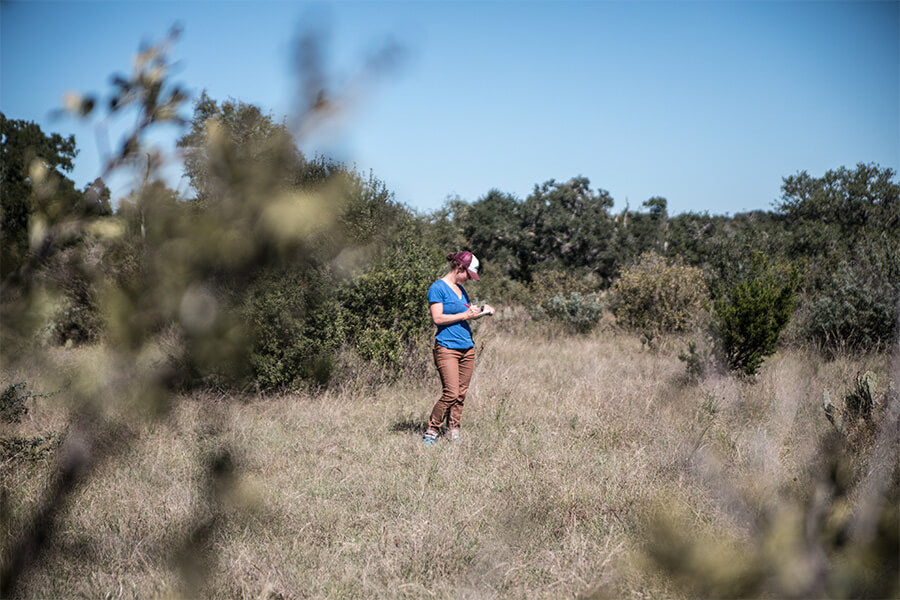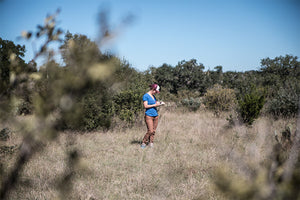This is part of our ROAM series, which charts the progress of our recently acquired ranch in the Texas Hill Country. Read the first piece here.
When we purchased ROAM Ranch earlier this year, the property had historically been treated like a monoculture — an unnatural setup where a single crop is grown. Consequently, the soil was barren, no insects were present, and the once-lush prairie grass composed of hundreds of plant species had been diminished to only a handful of varieties. The land’s degeneration was so severe the property couldn’t support the bison herd we planned to graze. It was unbelievable — so we decided to pivot our long-term regeneration plan.

Our patience was tested right away. Instead of activating the land from the start, we decided the best course of action was to give it time to “rest.” This meant clearing it of animals to temporarily let the grasses go to seed and ensure its residual pesticides wore off. Amid this “resting” phase, we’ve been able to better study the land and focus on getting ourselves acquainted with its intricacies. And in just a few short months, we’ve already seen crucial biodiversity return to the property at an incredible rate. Nearly every week, it seems like I spot a new species of grass, a desirable insect, or migratory bird! It’s stunning, and a sign of many more good things to come.
Biodiversity is vital for every thriving ecosystem, you see. Mammals, birds, insects, and the billions of fungi and bacteria beneath the soil have co-evolved for millions of years to support a natural system on which all forms of life depend. When rich with diversity, these habitats stay balanced and healthy through complex processes of symbiosis, competition, and predation. And if they’re allowed to function properly, these biomes — vast ecosystems — will thrive over time and become increasingly fertile as the years pass. That’s why the accelerating return of this biodiversity to ROAM is so exciting — it’s a clear sign the ecosystem is gaining momentum.
All of this speaks to regenerative ranching all-star Will Harris’ favorite saying: “nature abhors monoculture.” That’s why, when it comes to grand-scale agriculture, farmers must adapt their business models to account for their operation’s impact on larger ecosystems. As it stands, conventional farming is grounded in conformity, commoditization, and efficiency. This industrial model has little care for natural systems, creating monocultures of row crops that displace native wildlife, repel migratory birds, and poisons insects. Worst of all, it destroys soil biology through the intensive use of chemical fertilizers and devastating tilling practices. So the next time you catch yourself admiring the ‘beauty’ of a massive cornfield, don’t be fueled — that ecosystem is 100% dependent on petroleum-based inputs and is nothing but a lifeless wasteland in direct conflict with natural order. The time for change has come.
The question is, how we can accelerate the growth of ROAM’s biodiversity even more? That’s where the noble pollinator comes in! These little guys play a primary role in the maintenance and proliferation of terrestrial ecosystems by facilitating plant reproduction, which is essential to our entire planet’s health. Although hummingbirds, butterflies, and many other animals serve as pollinators, honeybees are by far the most effective and hasten the regrowth of wildflowers, native grasses, and other desirable forage — which is why we introduced 20,000 of them onto the ranch in late July! Since then, we have seen our EPIC hives double in size and are rapidly move towards an expected 80,000 bees by the end of the year. Although we are planning to introduce a second wave of them in a new area of the ranch this month, our long-term goal is to one day have over 3 million bees that call ROAM Ranch home. We know they’ll get along great with the insects, birds, and EPIC bison herd who will be their neighbors.

The role of the EPIC bee colony is simple: wake up, find plants with pollen, convert that pollen into food (honey), and reproduce. Allowing these insects to express their natural behaviors has added massive value to the land on which they depend. It’s a symbiotic relationship, after all. Through pollen collection, the bees are constantly fertilizing a diverse mixture of plants and optimizing their ability to reproduce! Unsurprisingly, we have seen the ranch’s biodiversity grow by leaps and bounds — and we have the bees to thank.
Big things are happening. When our bison arrive at ROAM later this year, they will be greeted with a diverse salad bowl of native grasses and forbes. As they do their part to increase the land’s fertility, they will further accelerate the diversity of biological matter and optimize the soil to support more grass. Once it gets rolling, this symbiotic system will continue to improve year over year and will provide a healthier environment for our animals and the ranch itself. When this all comes together, the end result for the EPIC consumer will be a thriving ecosystem capable of capturing massive amounts carbon from the atmosphere while producing nourishing meat and rich, flavorful honey. Sounds like an EPIC win-win-win to me!



